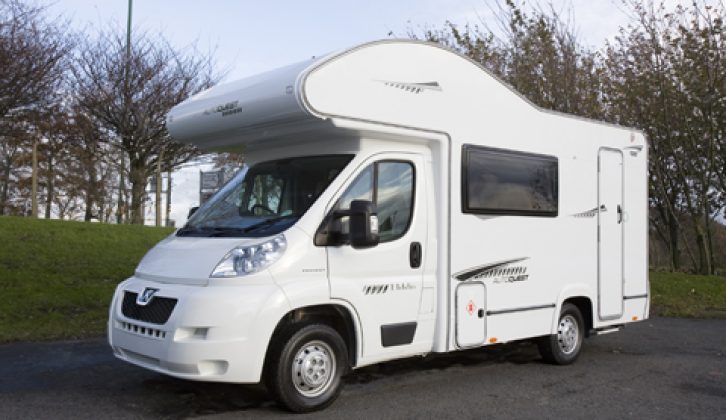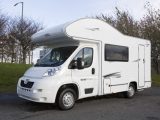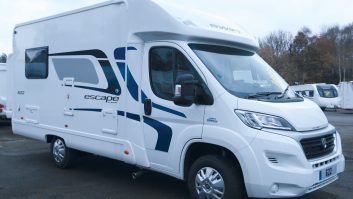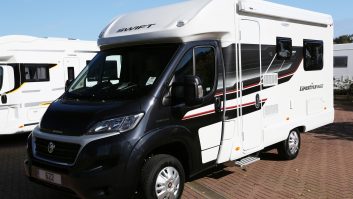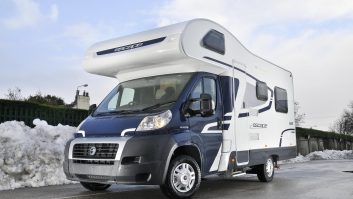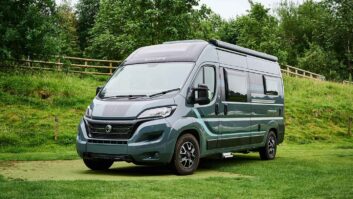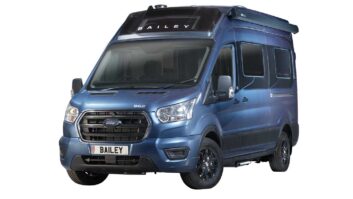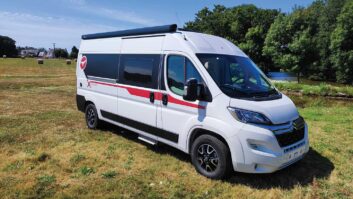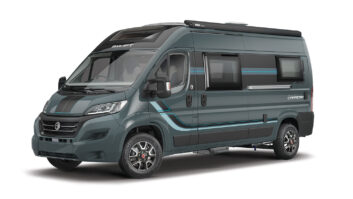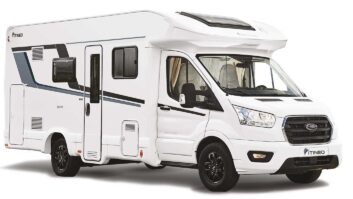Verdict
The Escape has all the quality hallmarks of Swift’s design and manufacturing know-how, at a bargain price. For buyers looking for independence and the chance to get away from it all for less cash than they might expect, it ticks a lot of boxes.
Pros
Well-equipped washroom; comfortable overcab bed; good wardrobe space
Cons
No wallboard for the sofa backrest; low-spec kitchen
The Escape is striking, thanks to its blue paintwork and bold graphics. It has a similar appearance to the Swift Group’s original Sundance motorhomes, launched back in 2001; that range was later tweaked to target the mid-market.
The swoop of the Escape’s overcab mould looks familiar (minus the GRP lip), as does the aluminium extrusion that conceals the joins between sidewalls, roof and rear panel. Also, the low-line 664 Escape gets the same pod used for low-profile Sundances.
All four Escape models are based on the Fiat Ducato, and powered by the 100 Multijet engine with five-speed gearbox as standard. We found the engine man enough to motor our (unladen) 6.3m-long 624 test model in MWB form, with thoughtfully spaced gear ratios. For the 686 model, which is a shade under 7m in length, it might be wise to go for the 130 Multijet option with six-speed ’box.
There’s little evidence of cost cutting in the cab – the seats are upholstered to match the living quarters, with single armrests and a drop-in carpet. However, electric mirrors and a passenger airbag are not available.
All four models (the 622, 624, 664 and 686) offer multiple sleeping berths. Our 624 had two belted passenger seats on its forward-facing sofa, and was plated at 3300kg. This means 416kg of usable payload; adequate for a young family.
Some detailing comes from the group’s expertise in touring-caravan manufacture: for example, there’s an external-access locker housing the leisure battery and mains electric input, which enables the owner to secure the cable when in use by locking the door.
The water tanks are a good size (the 70-litre fresh tank is onboard) with rigid wide-bore drain pipes, and there’s a proper underslung spare wheel rather than a foam puncture-repair kit.
The manual entry step and the unfussy entry door hint at the basic specification, as do the chassis extensions, which seem simple compared with the heavy-duty versions (fitted to higher-priced Swift Group kit) that can accommodate a towbar.
Inside, the stylish locker doors come without handles, but still have positive locking mechanisms (open them by means of a barrel latch just beneath the face), and a drop-in carpet covers the woodblock-effect vinyl flooring. A Heki rooflight floods the lounge area with light, and the seat cushions are hook-and-fastened and press-studded in place, so they don’t fly about in transit.
There’s no wallboard for the sofa backrest, which may throw up condensation issues in time. The directional reading lights under the lockers are of the roller-ball kind, and in the kitchen area chefs will have to make do with a combined oven and grill, and three-burner hob. The kitchen storage is devoid of fancy vegetable racks – there are just good old-fashioned lockers. The 80-litre Thetford fridge has three-way power controls, but they are manually operated.
None of this is to detract from what really is a very impressive overall package in this price bracket. Take the washroom: not only does it offer the modern-looking Thetford C250 cassette toilet with wheeled holding tank, but unlike many ‘budget’ motorhomes, it has a dedicated trigger-type shower head that’s separate from the tap in the corner basin.
The overcab bed base is hinged and raises on gas struts, too; it’s not the aluminium-framed, slatted base that’s offered in higher-spec Swift products, but the mattress is perfectly comfy.
Once again, Swift Group has proven adept at reading market conditions and delivering the right product at the right time.
Technical Specifications
| Payload | 416 kg |
| MTPLM | 3300 kg |
| Shipping Length | 6.30 m |
| Width | 2.24 m |
